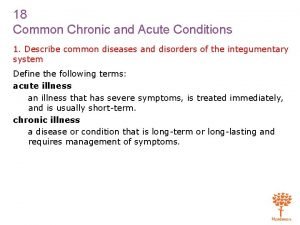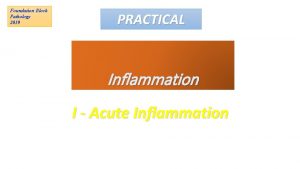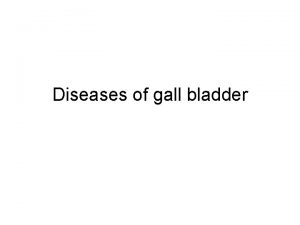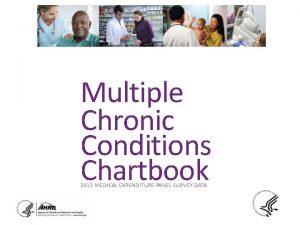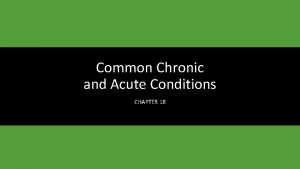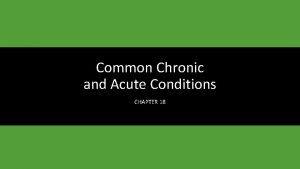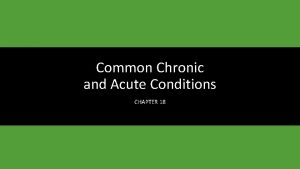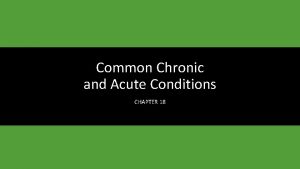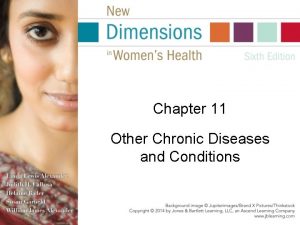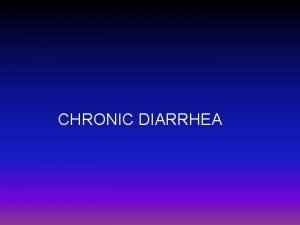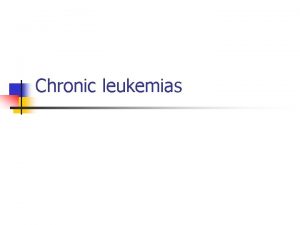CHAPTER 18 COMMON CHRONIC AND ACUTE CONDITIONS LEARNING

















- Slides: 17

CHAPTER 18: COMMON CHRONIC AND ACUTE CONDITIONS

LEARNING OBJECTIVES Describe common diseases and disorders of the integumentary system Describe common diseases and disorders of the musculoskeletal system Describe common diseases and disorders of the nervous system Describe common diseases and disorders of the circulatory system Describe common diseases and disorders of the respiratory system Describe common diseases and disorders of the endocrine system Describe common diseases and disorders of the reproductive system Describe common diseases and disorders of the immune and lymphatic system Identify community resources for residents who are ill

DISEASES AND DISORDERS OF THE INTEGUMENTARY SYSTEM Shingles Eczema Wounds Stasis dermatitis Dermatitis Fungal infections

DISEASES AND DISORDERS OF THE MUSCULOSKELETAL SYSTEM Arthritis Hip replacement Facts Treatment Care guidelines Facts Reasons for hip replacement Care guidelines Signs and symptoms to report Osteoporosis Facts Signs and symptoms How to prevent or slow Knee replacement Fractures Muscular dystrophy Prevention Cast care guidelines Facts Reasons for knee replacement Care guidelines Amputation Guidelines for care

COMMON DISEASES AND DISORDERS OF THE NERVOUS SYSTEM CVA/Stroke Head and spinal cord injuries Facts Care guidelines Parkinson’s disease Epilepsy Facts Care guidelines Facts Multiple sclerosis Care guidelines Vision impairment Facts

DISEASES AND DISORDERS OF THE CIRCULATORY SYSTEM Hypertension (HTN) Congestive heart failure (CHF) Facts Care guidelines Coronary artery disease (CAD) Peripheral vascular disease (PVD) Facts Care guidelines Facts Heart attack/myocardial infarction Facts Care guidelines

SKILL: PUTTING ELASTIC STOCKINGS ON A RESIDENT Equipment: elastic stockings 1. Identify yourself by name. Identify resident by name. 2. Wash your hands. 3 Explain procedure to resident. Speak clearly, slowly, and directly. Maintain face-to-face contact whenever possible. 4. Provide for resident’s privacy with curtain, screen, or door. 5. The resident should be in the supine position (on her back) in bed. With resident lying down, remove her socks, shoes, or slippers, and expose one leg. Expose no more than one leg at a time. 6. Turn stocking inside-out at least to heel area. 7. Gently place the foot of the stocking over toes, foot, and heel. Make sure the heel is in the right place (heel of foot should be in heel of stocking). 8. Gently pull the top of stocking over foot, heel, and leg. 9. Make sure there are no twists or wrinkles in stocking after it is applied. It must fit smoothly. Make sure the heel of stocking is over the heel of foot. If the stocking has an opening in the toe area, make sure the opening is either over or under the toe area, depending upon the manufacturer’s instructions. 10. Repeat for the other leg. 11. Place call light within resident’s reach. 12. Wash your hands. 13. Report any changes in resident to nurse. 14. Document procedure using facility guidelines.

COMMON DISEASES AND DISORDERS OF THE RESPIRATORY SYSTEM Chronic obstructive pulmonary disease (COPD) Facts Symptoms Care guidelines Signs and symptoms Asthma Facts Bronchiectasis Facts Upper respiratory infections (URIs) Facts Lung cancer Facts Tuberculosis Facts

SKILL: COLLECTING A SPUTUM SPECIMEN Equipment: specimen container with completed label (labeled with resident’s name, date of birth, room number, date, and time) and lid, specimen bag, tissues, gloves, N 95 or other ordered mask, laboratory slip 1. Identify yourself by name. Identify resident by name. 2. Wash your hands. 3. Explain procedure to resident. Speak clearly, slowly, and directly. Maintain face-to-face contact whenever possible. 4. Provide for resident’s privacy with curtain, screen, or door. 5. Put on mask and gloves. Coughing is one way that TB bacilli can enter the air. Stand behind the resident if the resident can hold the specimen container by himself. 6. Ask the resident to cough deeply, so that sputum comes up from the lungs. To prevent the spread of infectious material, give the resident tissues to cover his mouth while coughing. Ask the resident to spit the sputum into the specimen container. 7. When you have obtained a good sample (about two tablespoons of sputum), cover the container tightly. Wipe any sputum off the outside of the container with tissues. Discard the tissues. Apply label, and place the container in a clean specimen bag. 8. Remove and discard gloves and mask. 9. Wash your hands. 10. Place call light within resident’s reach. 11. Report any changes in resident to the nurse. 12. Take specimen and lab slip to proper area. Document procedure using facility guidelines.

COMMON DISEASES AND DISORDERS OF THE ENDOCRINE SYSTEM Diabetes Types Facts Signs Complications Care guidelines Signs and symptoms to report

SKILL: PROVIDING FOOT CARE FOR THE DIABETIC RESIDENT Equipment: basin, bath thermometer, mild soap, washcloth, 2 towels, lotion, cotton socks, shoes or slippers, gloves 1. Identify yourself by name. Identify resident by name. 2. Wash your hands. 3. Explain procedure to resident. Speak clearly, slowly, and directly. Maintain face-to-face contact whenever possible. 4. Provide for resident’s privacy with curtain, screen, or door. 5. Fill the basin halfway with warm water. Test water temperature with thermometer or against the inside of your wrist. Ensure it is safe. Water temperature should be no higher than 105°F. Have resident check water temperature. Adjust if necessary. 6. Place basin on a bath towel on the floor (if the resident is sitting in a chair) or at the foot of the bed (if the resident is in bed). Make sure basin is in a position that is comfortable for the resident. Support the foot and ankle throughout the procedure. 7. Put on gloves. 8. Remove the resident’s socks, and completely submerge the resident’s feet in the water. Soak the feet for 10 to 20 minutes. 9. Put soap on a wet washcloth. Remove one foot from the water. Wash the entire foot gently, including between the toes and around nail beds. 10. Rinse the entire foot, including between the toes. Continue on next slide

SKILL: PROVIDING FOOT CARE FOR THE DIABETIC RESIDENT (CONTINUED) 11. Using a towel, pat the foot dry gently, including between the toes. 12. Repeat steps 9 through 11 for other foot. 13. Starting at the toes and working up to the ankles, gently rub lotion into the feet with circular strokes. Your goal is to increase circulation, so take several minutes on each foot. Do not put lotion between the toes. 14. Observe the feet, ankles, and legs for dry skin, irritation, blisters, redness, sores, corns, discoloration, or swelling. 15. Help resident put on socks and shoes or slippers. 16. Put soiled linens in appropriate container. Pour water into the toilet and flush it. Place basin in proper area for cleaning or clean and store it according to facility policy. Store supplies. 17. Remove and discard gloves. 18. Wash your hands. 19. Place call light within resident’s reach. 20. Report any changes in resident to the nurse. 21. Document procedure using facility guidelines.

COMMON DISEASES AND DISORDERS OF THE ENDOCRINE SYSTEM Hyperthyroidism Facts Hypothyroidism Facts

COMMON DISEASES AND DISORDERS OF THE REPRODUCTIVE SYSTEM Sexually transmitted infections (STI) Prostatic hypertrophy Chlamydia Syphilis Gonorrhea Genital herpes Facts Vaginitis Facts

COMMON DISEASES AND DISORDERS OF THE IMMUNE AND LYMPHATIC SYSTEMS HIV/AIDS Cancer Facts Signs and symptoms Opportunistic infection High-risk behaviors Measures to protect against spread Care guidelines Facts Risk factors Warning signs Treatments Care guidelines Things to observe and report

COMMUNITY RESOURCES FOR RESIDENTS WHO ARE ILL The following groups may be of assistance: American Cancer Society (cancer. org) National Association of Area Agencies on Aging (n 4 a. org) provides Eldercare Locator. Many organizations assist those dealing with HIV/AIDS: aids. gov cdc. gov/hiv aidsinfo. nih. gov

REVIEW Describe common diseases and disorders of the integumentary system Describe common diseases and disorders of the musculoskeletal system Describe common diseases and disorders of the nervous system Describe common diseases and disorders of the circulatory system Describe common diseases and disorders of the respiratory system Describe common diseases and disorders of the endocrine system Describe common diseases and disorders of the reproductive system Describe common diseases and disorders of the immune and lymphatic system Identify community resources for residents who are ill
 Chapter 18 common chronic and acute conditions
Chapter 18 common chronic and acute conditions Cardinal sign of inflammation
Cardinal sign of inflammation Acute inflammation
Acute inflammation Leukemia survival rate
Leukemia survival rate Periradicular tissue
Periradicular tissue Acute cholecystitis vs chronic cholecystitis
Acute cholecystitis vs chronic cholecystitis Acute subacute chronic
Acute subacute chronic Hetrotropia
Hetrotropia Acute vs chronic heart failure
Acute vs chronic heart failure Multiple chronic conditions chartbook
Multiple chronic conditions chartbook Cuadro comparativo e-learning m-learning b-learning
Cuadro comparativo e-learning m-learning b-learning Lcm of 12 and 18
Lcm of 12 and 18 Common anode and common cathode
Common anode and common cathode Hcf method
Hcf method How to find lowest common factor
How to find lowest common factor What is the least common multiple of 18 and 27
What is the least common multiple of 18 and 27 Highest common factors and lowest common multiples
Highest common factors and lowest common multiples Conclusion of gagne theory
Conclusion of gagne theory
